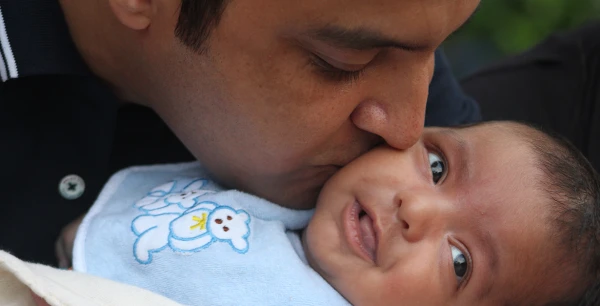 I think that the term ‘self soothe’ has received a bad reputation. People misunderstand what it actually means, and immediately reach the conclusion that ‘self-soothing’ involves parents ignoring their children, lots of crying, and even neglect. This is unfortunate, as self-soothing is an important life skill, not only when your baby is young, but as they grow and eventually become responsible, self-regulating adults.
I think that the term ‘self soothe’ has received a bad reputation. People misunderstand what it actually means, and immediately reach the conclusion that ‘self-soothing’ involves parents ignoring their children, lots of crying, and even neglect. This is unfortunate, as self-soothing is an important life skill, not only when your baby is young, but as they grow and eventually become responsible, self-regulating adults.
When you come home from a frustrating day at work, are stuck in traffic, or have to deal with another upsetting circumstance, you have a choice. You can either throw an adult-sized temper tantrum, or you can deal with the situation calmly. This ability to self-regulate and self-soothe is an important life skill. Self-regulation is not something that we inherently know how to do, rather, it’s something that parents have to teach their children, both through lesson and example.
You may be wondering what self-regulation and self-soothing has to do with sleep, and the answer is, simply put, everything. When you first bring home your baby, they are completely dependent on you for every little thing. They need to be fed, changed, and coaxed to sleep. It’s not until around six months that babies begin to be capable of self-soothing. The problem is that there isn’t a switch that turns this skill on. Your baby needs you to teach him about self-regulation.
In order to understand why your child needs to self-soothe, let’s talk for a minute about bedtime routines, specifically that part of the routine where your child is falling asleep. Ask yourself these questions:
- Are you putting your baby into bed completely asleep?
- Is your baby even aware that he is being moved into the bed?
- Does mom or dad have to rock, nurse, pat, feed, walk, or even lie down with him every night in order to ensure that he falls asleep?
- Does your baby know that you leave the room after he’s asleep?
If you can identify with any of the above questions, it is very likely that your child does not know how to self-regulate, and is relying on you to do it for her.
In reality, your six month old baby (or even your toddler) is ready to learn how to self-regulate, he just doesn’t know it yet. As parents we constantly worry that our baby isn’t getting some basic need (like sleep), unless we do it for them and ensure that it actually happens. A fun fact: Did you know that it takes the average adult approximately 20-minutes to fall asleep? If you fall right to sleep, normally that is an indicator that you are sleep deprived. Knowing this, it goes to reason that our children need the same amount of time to process their day and fall peacefully to sleep.
If you are rocking, feeding, patting, or lying with your baby to help her fall asleep, you are actually creating a sleep crutch. A sleep crutch is just my name for an activity (such as rocking) that your baby becomes dependent upon in order to fall to sleep. While this isn’t a big deal those first six months (remember, your newborn actually does need you to do it for her), at three years old (if you haven’t done any sleep coaching by then), it can become exhausting. This is compounded by the fact that your child requires this same sleep crutch with every awakening. So how can we resolve this?
Understand that your baby does not need you to put him to sleep
At some point, your baby needs to learn to put himself to sleep. The sooner that you address this basic need, the better everyone will sleep. I would encourage you to use The Shuffle to help your baby become gradually accustomed to putting himself to sleep.
Remember, drowsy but AWAKE
Imagine one minute being safely in mom’s (or dad’s) arms, and then all of a sudden, you wake up in a different place, and mom is nowhere in sight. That’s pretty scary, if you ask me. But, if your baby knows that she’s being put in bed, and is happy, calm, and ready for sleep, when she partially awakens, the chance that she’s going to comfortably go back to sleep is much higher.
Be supportive, but don’t do it for him
Understand that teaching your baby to self-soothe is about being there while he figures it out. Rather than immediately popping his pacifier back into his mouth, allow him to search for it. Expect that the first few ventures into being self-reliant your baby may complain a bit, and that’s normal. Up to this point, you’ve done it for him. Remind yourself that you can provide moral support, and at the same time teach him that he is capable.
Pay attention to your baby’s cues
There is a subtle (but important) difference between a baby who is trying to fix a problem (like a lost pacifier or a brief, but unexpected awakening), and one who needs assistance. As I stated previously, expect that your baby will complain when faced with a slight struggle at first.
If she becomes very upset, remember that it is okay to provide reassurance through a few pats, or even a quick snuggle. Just be sure that you settle your baby back into bed quickly after they have calmed down and allow them to try again.
In her book Mind in the Making, researcher Ellen Galinsky shares findings from a study of pre-term infants in a neonatal intensive care unit. The findings of this study were very interesting. When the doctors and nurses took charge of a baby’s care without taking the time to read their cues, it was noted that “It seemed we were wasting a lot of the baby’s energies that were very precious.”Galinsky explains that “When a baby who was initially feisty gave in, the medical charts would record that the baby had become well adjusted.”But the researchers viewed this information a bit differently: “The baby had given up. The baby just let the world happen.”
“After documenting and recording behavior, they launched into a study where the nurses “read” and then responded to the baby’s behavior in ways that built on that baby’s coping strategies, and thus gave the baby more control. The results of this experiment were impressive. There was reduced severity of chronic lung disease in these premature babies, improved brain functioning, improved growth and earlier release from the hospital. In addition, their care was significantly less costly.”
Galinsky observed that “Children, even those as young as premature infants, are less prone to the harmful effects of stress when they are supported in managing their own stress by being helped to use the strategies they have for coping and for calming down.”
Have patience
While it’s much easier just to replace the pacifier or rock your baby all the way to sleep, remind yourself that the learning period is temporary. There will soon come a day when your baby doesn’t need your reassurance every time he loses his pacifier.
Lead by example
Beyond sleep, self-soothing is an important life skill. It’s this early lesson that allows us to deal with the traffic jams, the rough day at work, or disappointment without throwing a two-year-old sized fit. So next time you’re frustrated, remember that your baby is learning through your example.
How does your baby self-soothe?
Was this article helpful to you? Please tell us by commenting below! For more baby, toddler, and family sleep tips and tricks, please subscribe to The Sleep Lady’s Facebook, Twitter, Pinterest, Google+, and YouTube channel! If you are looking for more sleep content, please check out Get Sleep Now-an exclusive members-only area designed to provide in-depth help and support during your sleep coaching experience.
photo credit: storyvillegirl via photopin cc


